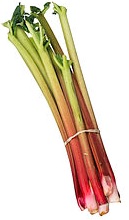 Growing Rhubarb - July 29, 2015 Jeff Schalau, Agent, Agriculture & Natural Resources University of Arizona Cooperative Extension, Yavapai County I’ve been asked several times what can be done to increase gardening success with rhubarb in north central Arizona. Our climate and soils are very different than other areas of the country (the Midwestern and Northeastern U.S.) where it grows relatively trouble free. Gardeners are always seeking a challenge and those wishing to grow rhubarb may increase their success by trying the recommendations presented here. The recommendations below come from Tuan Beddes, Horticulture Agent at Utah State University Extension and Bob Morris, retired University of Nevada Horticulture Agent. Rhubarb (Rheum rhabarbarum) is a perennial crop that prefers fertile, well-drained soils high in organic matter. Select a sunny garden location that can be devoted to rhubarb for many years. Avoid sites having reflected light or heat or that are excessively windy. If there are perennial weeds present, you must manage them and summer is a good time to do that for next year’s spring planting. Incorporate 2 to 4 inches of well-composted organic matter 6 inches deep into the soil where rhubarb is to be planted. Bob Morris also recommends adding a phosphorus fertilizer and a quality iron chelate to your soil-compost blend. A soil test will help determine soil nutrient deficiencies (see also February 25, 2015 Backyard Gardener – Garden Soil Amendments). Rhubarb is almost always planted from cuttings taken from healthy crowns. The cuttings should have at least one leaf bud on top and healthy roots (that may have been trimmed) on the bottom. Cuttings can be purchased online, via mail order or from local garden centers in late winter or early spring. Containerized, established plants are often available from local garden centers in late spring and early summer. Varieties can be selected based on information included with the online edition of this column (see URL below). Mature rhubarb plants can and should grow over 3 feet in height and width. Locate them where they will not interfere with other crops. Space plants every 3 feet. Plant crowns in prepared soil in early spring (February or March in the Verde Valley). Cover crowns with no more than 1 inch of soil. Firmly press soil above and around crowns then irrigate well. If more than one row is planted, space rows 4 feet apart. Irrigate newly planted rhubarb one to two times weekly so water penetrates to the bottom of the root-ball. Do not allow plants to dry too much for the first two years. Mulch plants with straw, grass clippings or bark to conserve soil moisture and reduce weed competition. Reduce irrigation frequency to once every 1 to 2 weeks after year 3, especially when mulch is applied around the plant. Irrigate so that water penetrates the soil 12 to 18 inches deep. If the leaves are scorching during the heat of the summer and the plant seems stunted, 30 to 40% shade cloth could be used to protect plants. Do not apply additional fertilizers during establishment – this should have already occurred with the compost, phosphorus, iron recommended above. Each year thereafter, apply 1/2 cup of 16-16-16 granular fertilizer (or composted manure equivalent) around the base of the plant just before leaves begin to emerge in the spring and lightly work into the soil. Maintain adequate mulch on your rhubarb plants/beds at all times. Rhubarb occasionally produces flower stalks. Like onions and garlic, flowering in rhubarb tends to reduce plant vigor and leaf and petiole production. Flower stalks should be removed just as they begin to elongate. Do not harvest any rhubarb stalks for the first 2 years. In the third year, stalks can be harvested for 3 to 4 weeks. After the fourth year, harvest stalks for 6 to 10 weeks or until plants begin to lose vigor. Stalks are ready for harvest when the petiole is 10 to 15 inches in length. To remove, grasp the stalk just below the leaf and pull upwards and to one side breaking it off rather than cutting it. This reduces the potential for disease. Only the stalks are edible, so all leaves should be removed and discarded or composted. Leave1/3 of stalks at any given time to maintain plant health. If you like rhubarb and enjoy edible gardening, then you should plant it! For additional information on growing rhubarb, see below. Follow the Backyard Gardener on Twitter. If you have other gardening questions, call the Master Gardener help line in the Camp Verde office at 928-554-8992 or e-mail us at verdevalleymg@gmail.com and be sure to include your name, address and phone number. Find past Backyard Gardener columns or provide feedback at the Backyard Gardener web site: http://cals.arizona.edu/yapai/anr/hort/byg/. Additional Resources Rhubarb in the Garden Utah State University Extension extension.usu.edu/files/publications/publication/HG_Vegetables_2011-01pr.pdf Growing Rhubarb in the Home Garden Ohio State University Extension ohioline.osu.edu/hyg-fact/1000/1631.html Heavily Amended Soil May Help Rhubarb Bob Morris, Las Vegas Review-Journal(10-27-11) www.reviewjournal.com/life/home-and-garden/heavily-amended-soil-may-help-rhubarb |